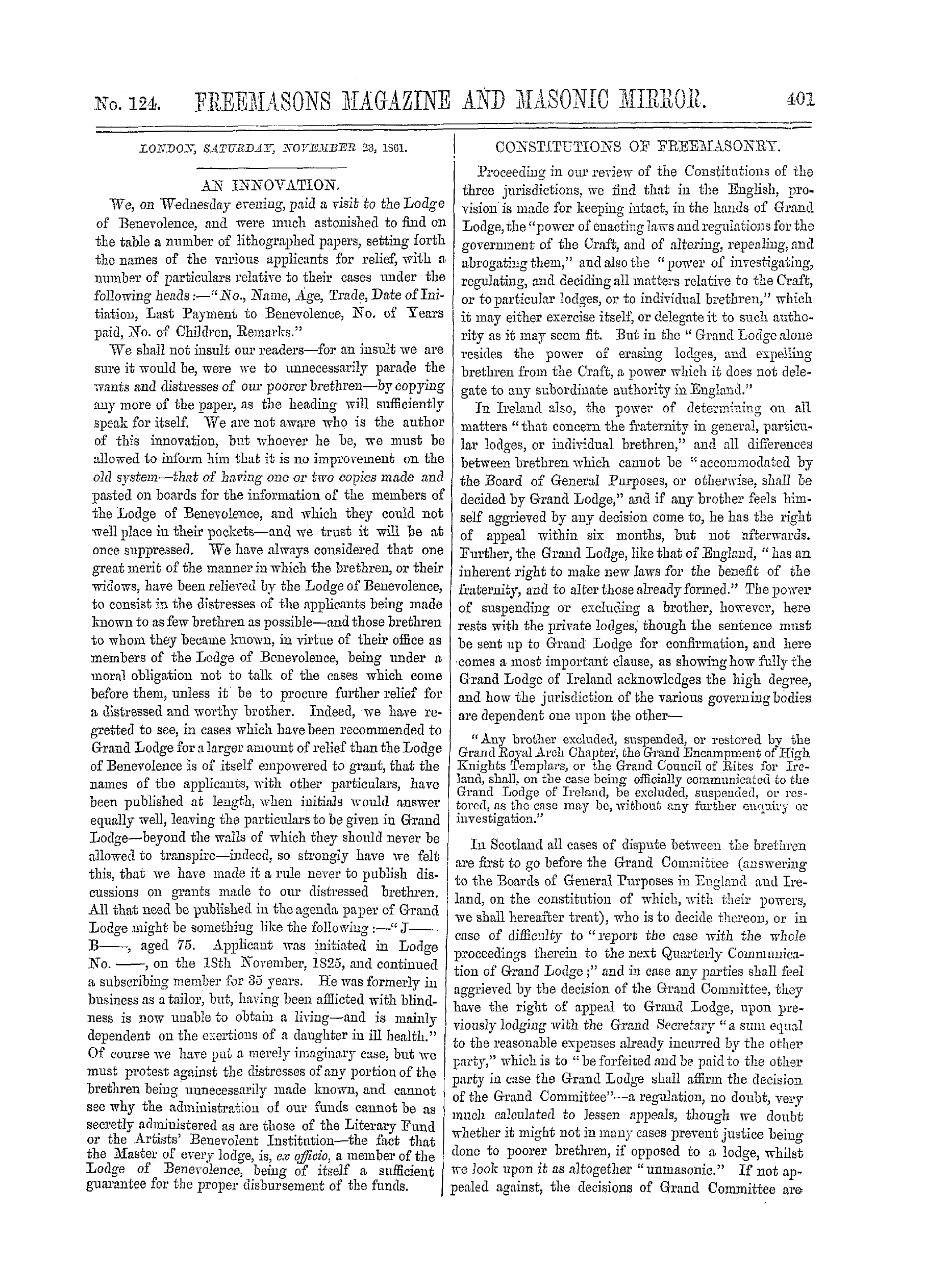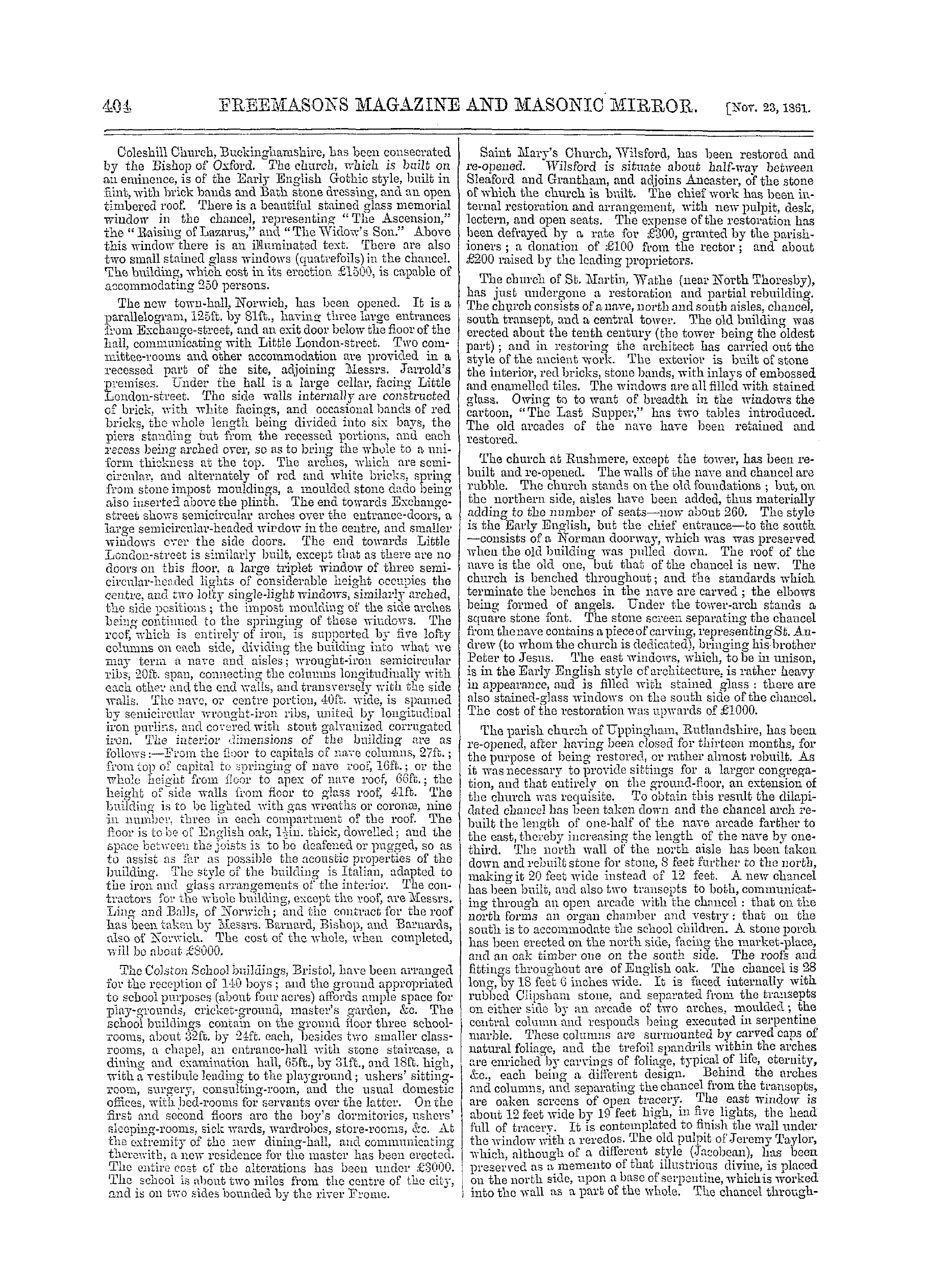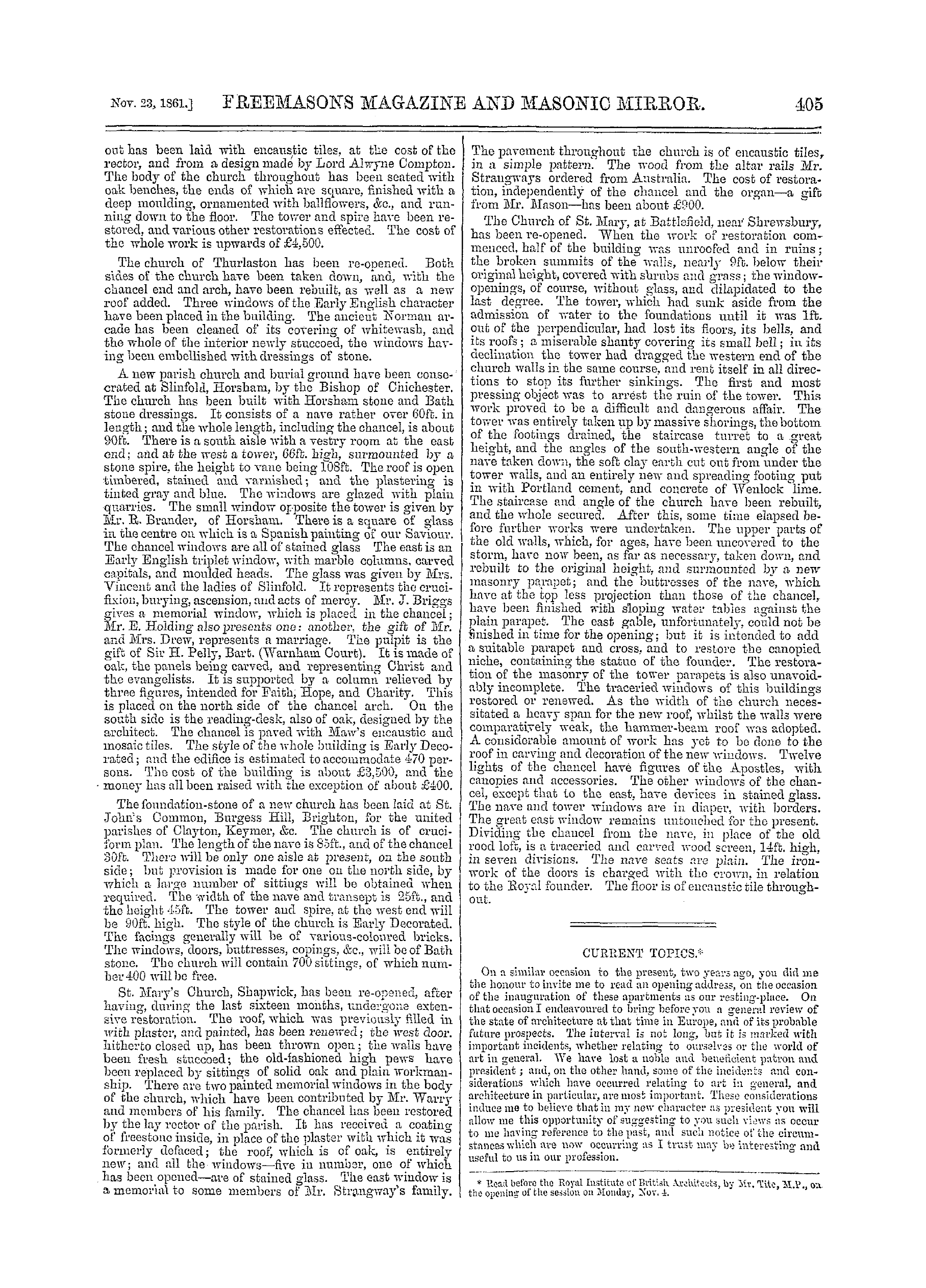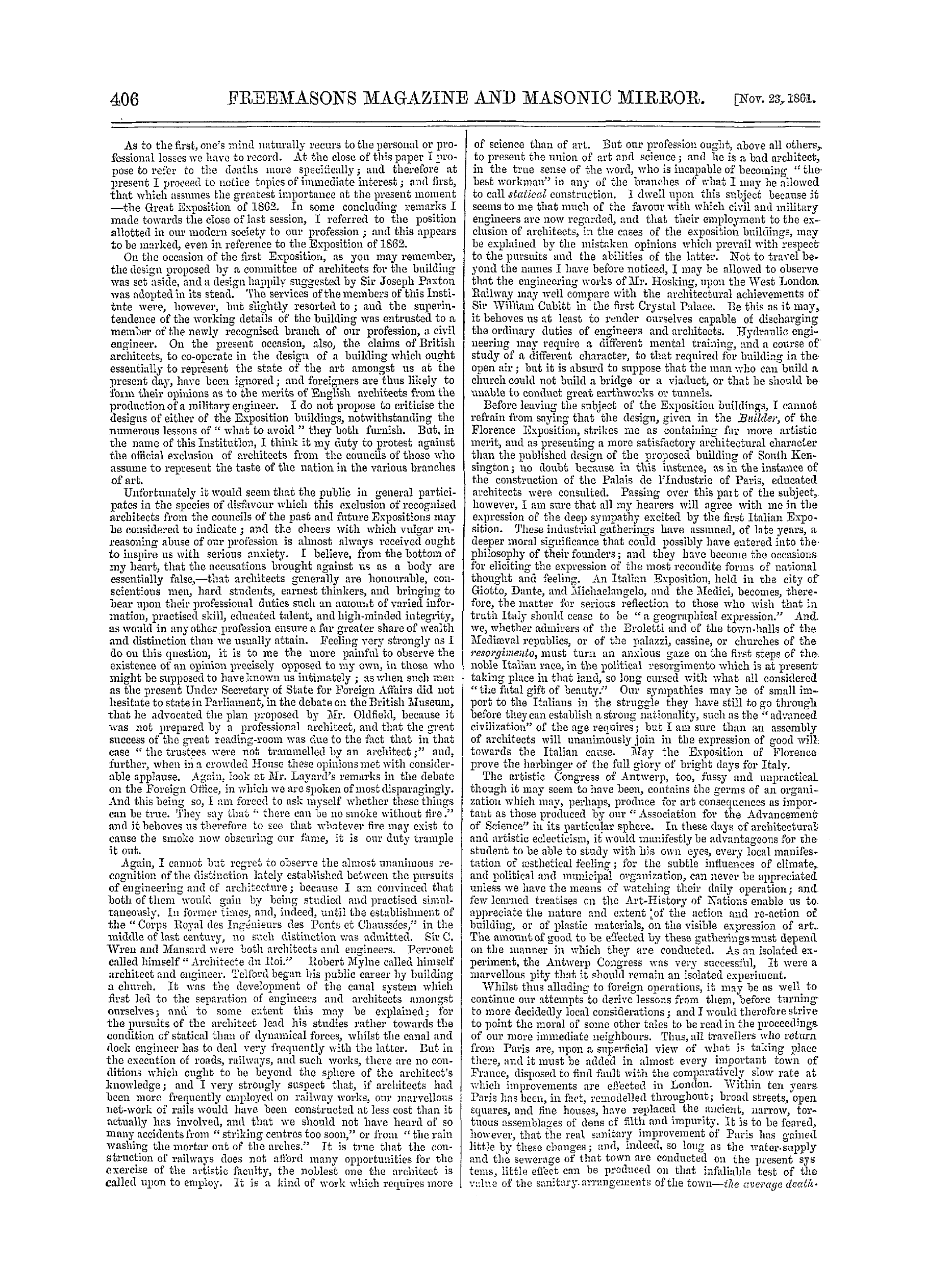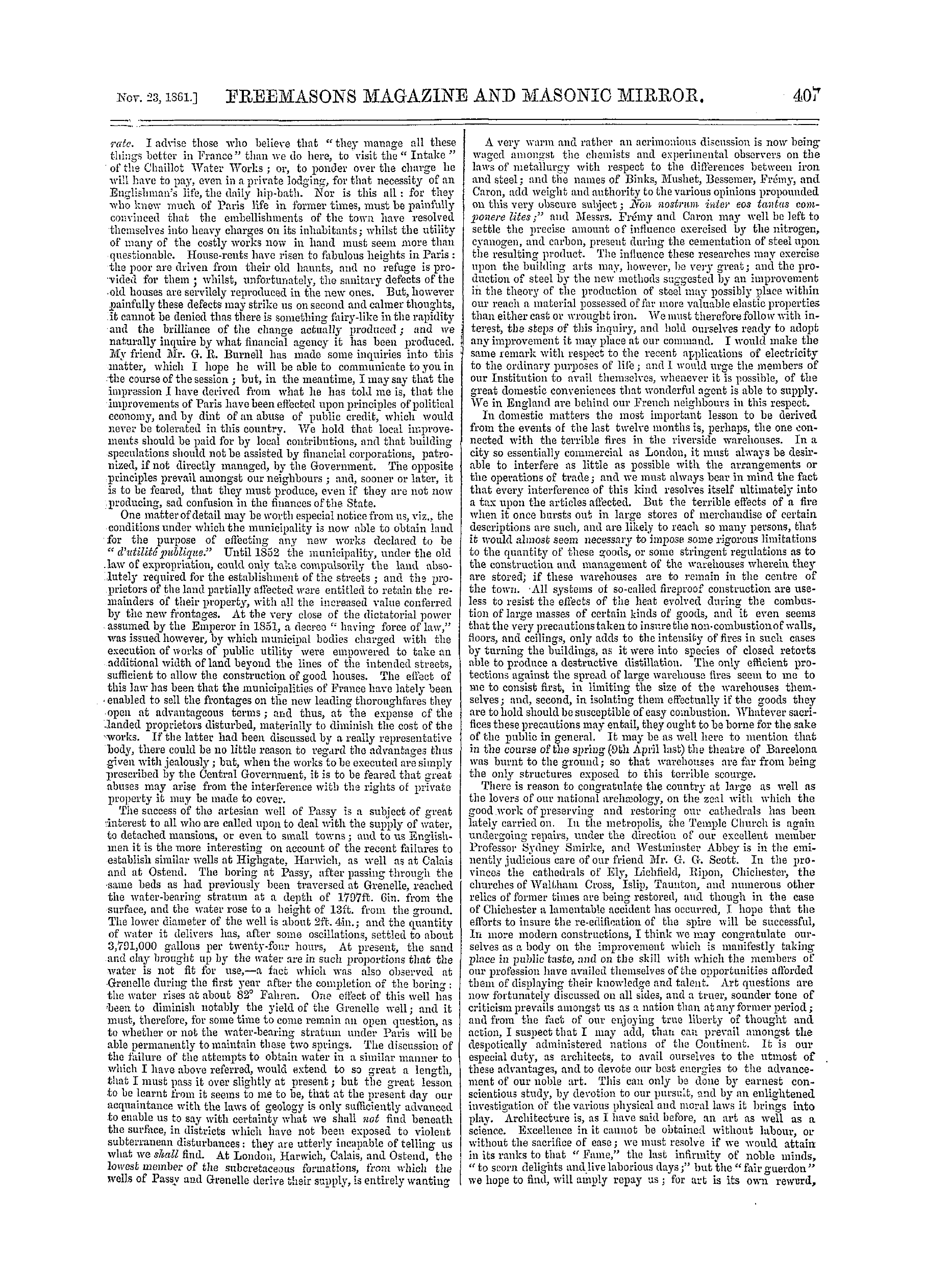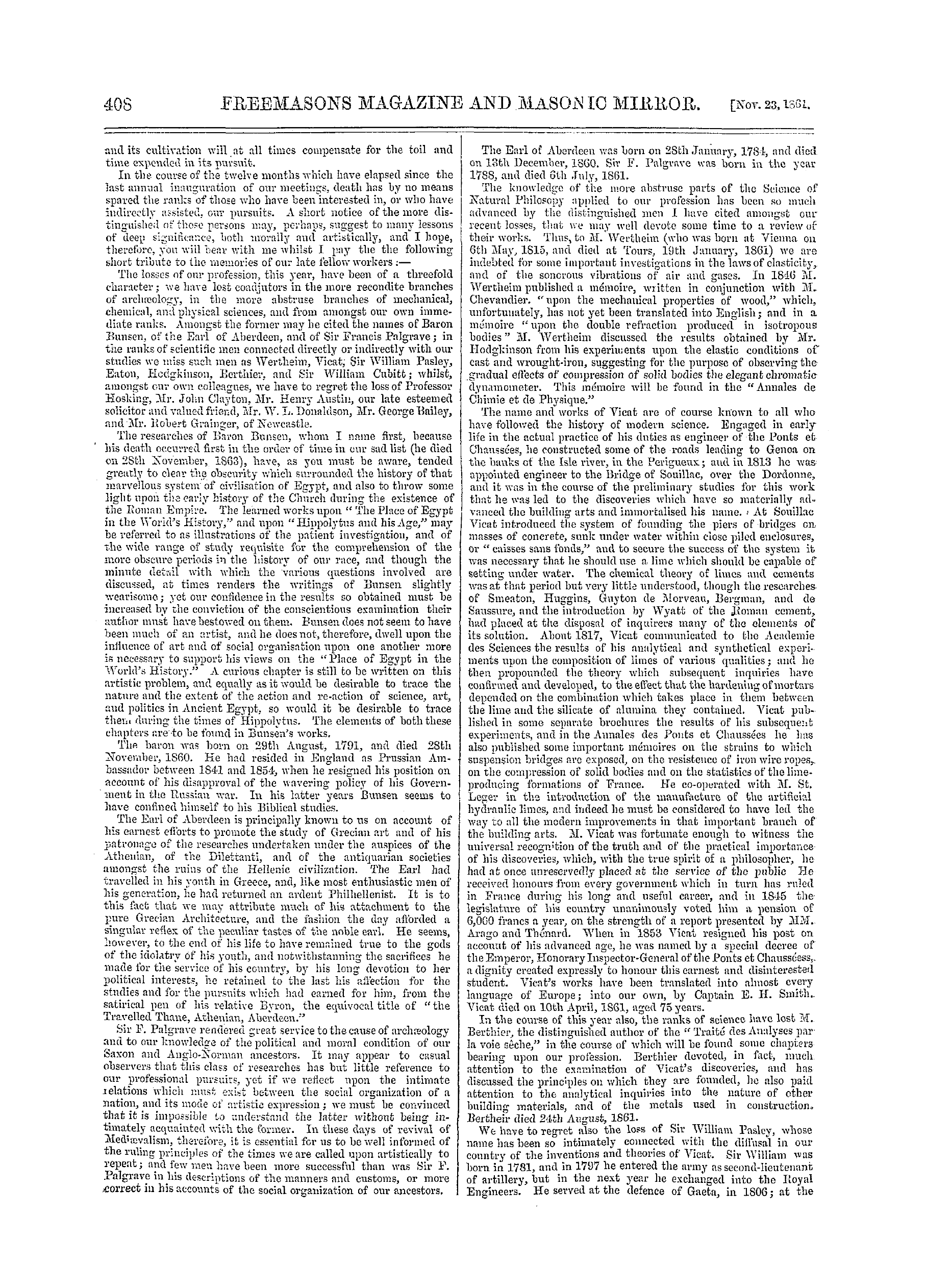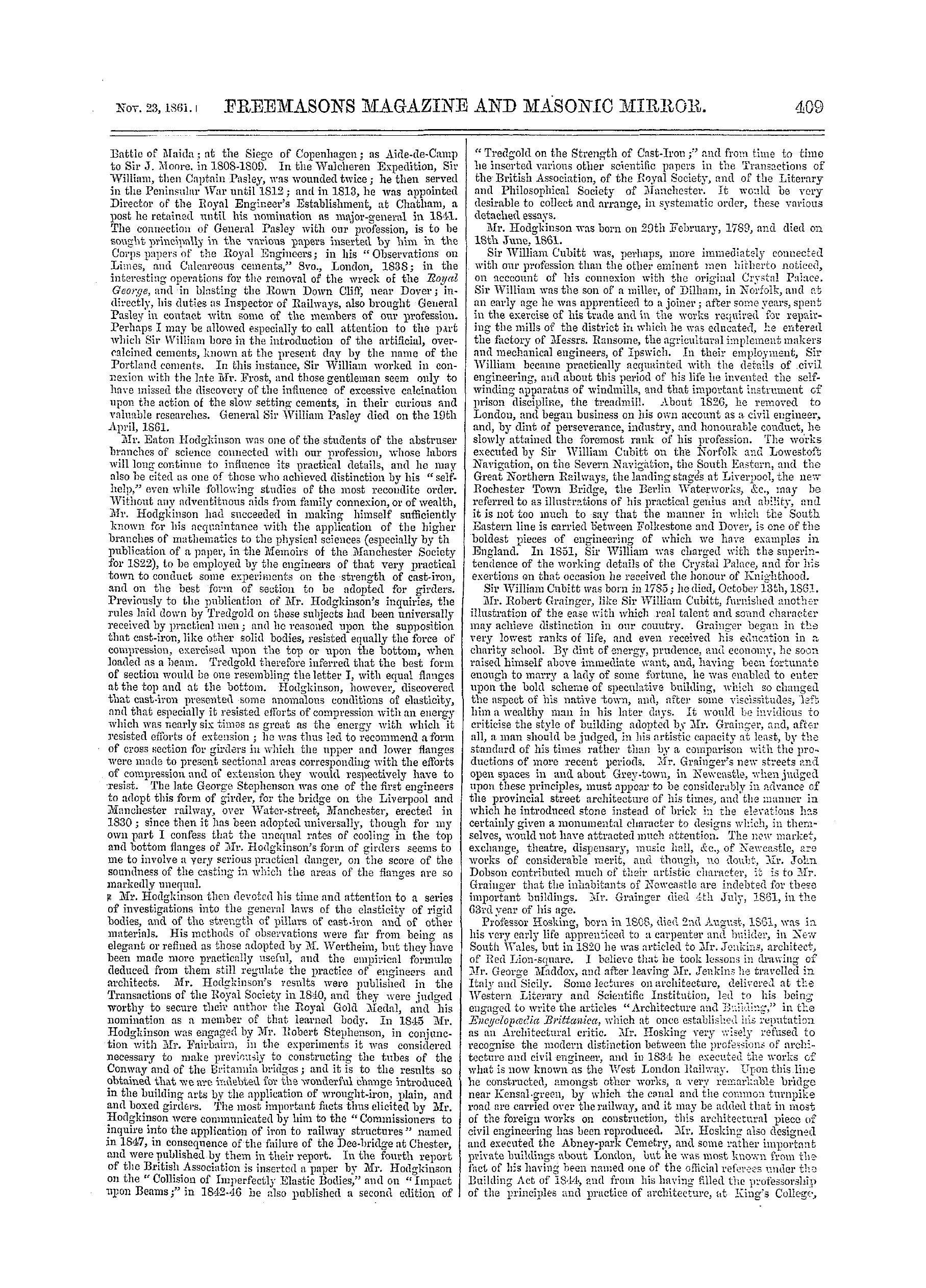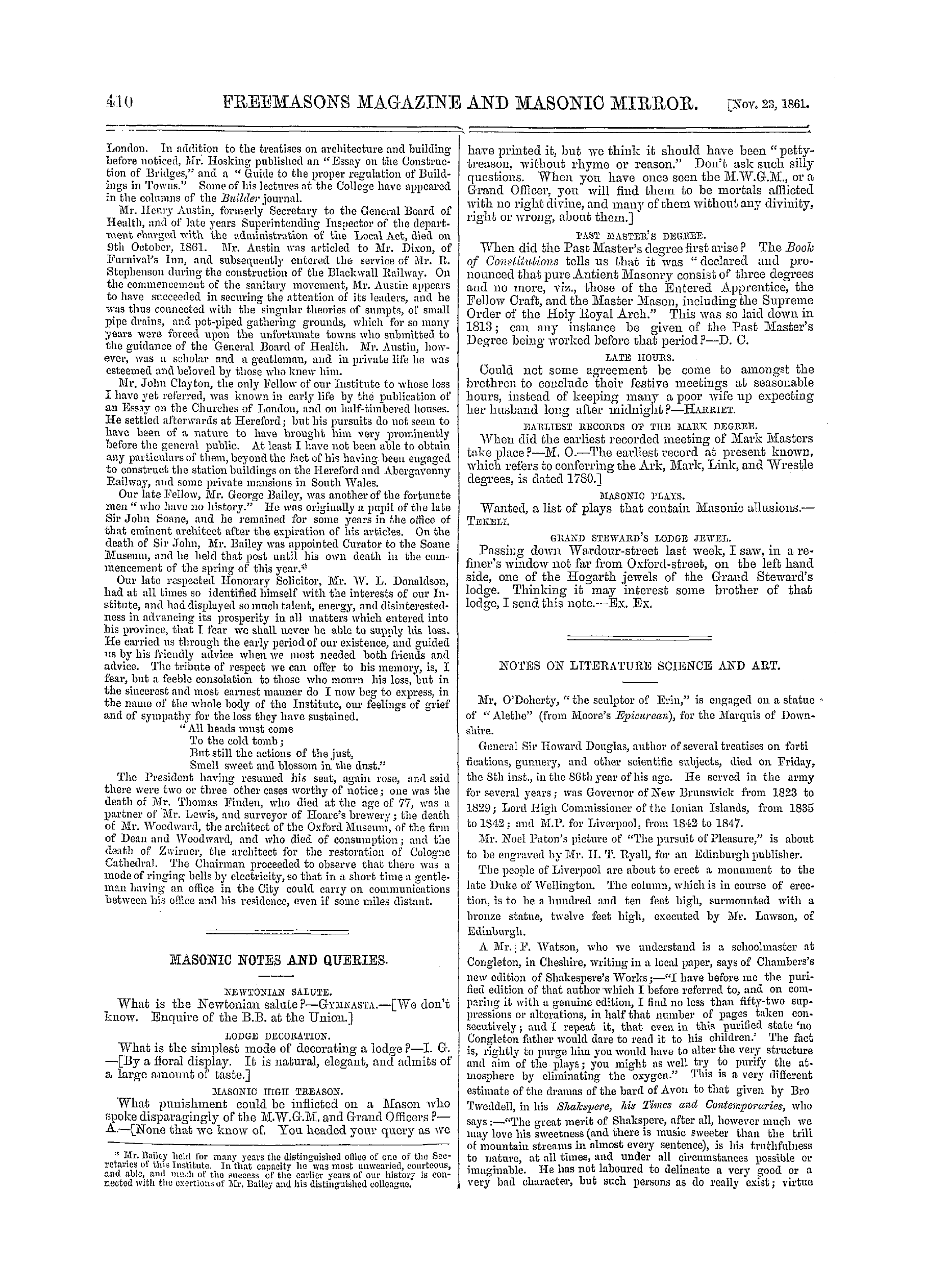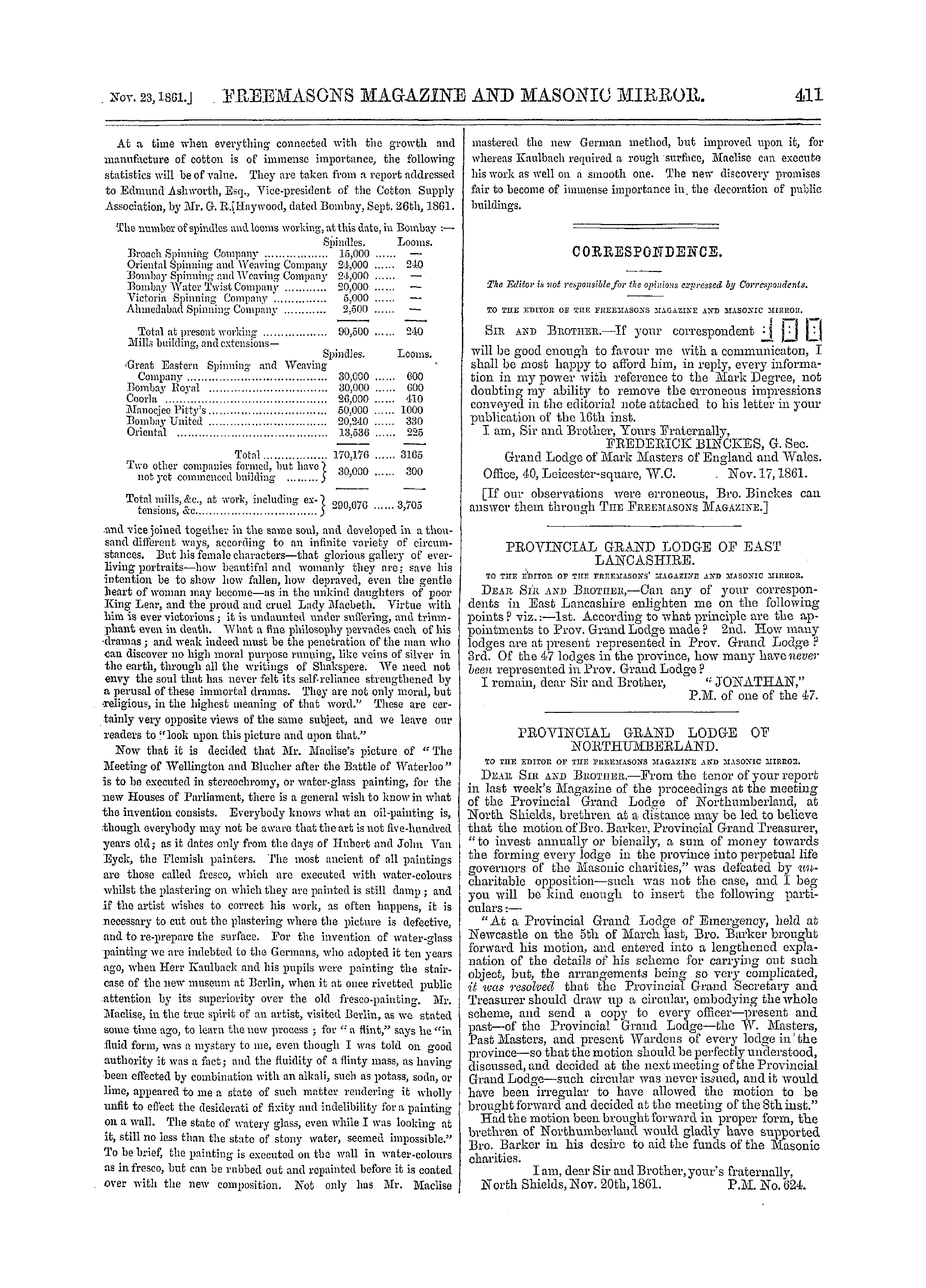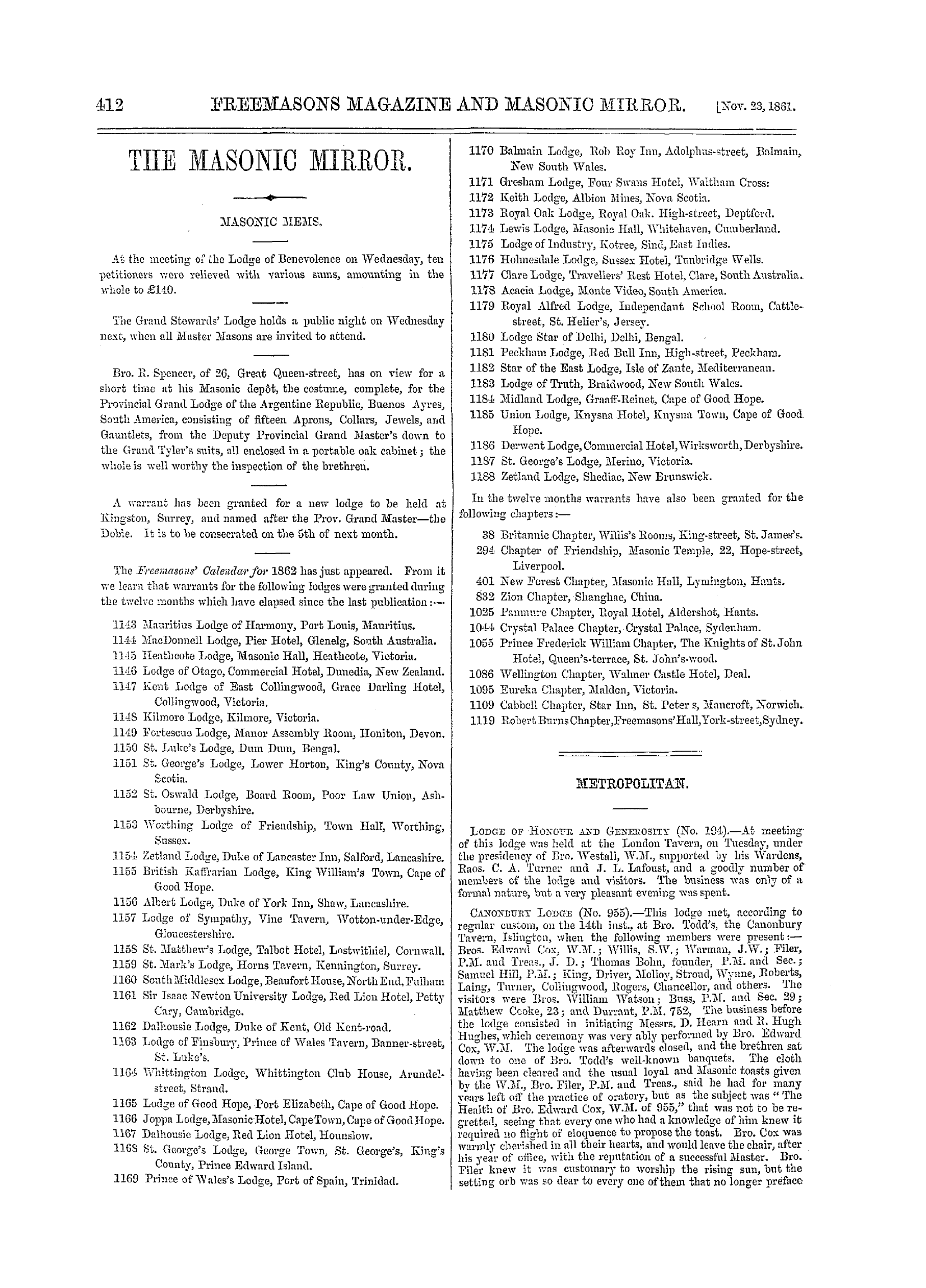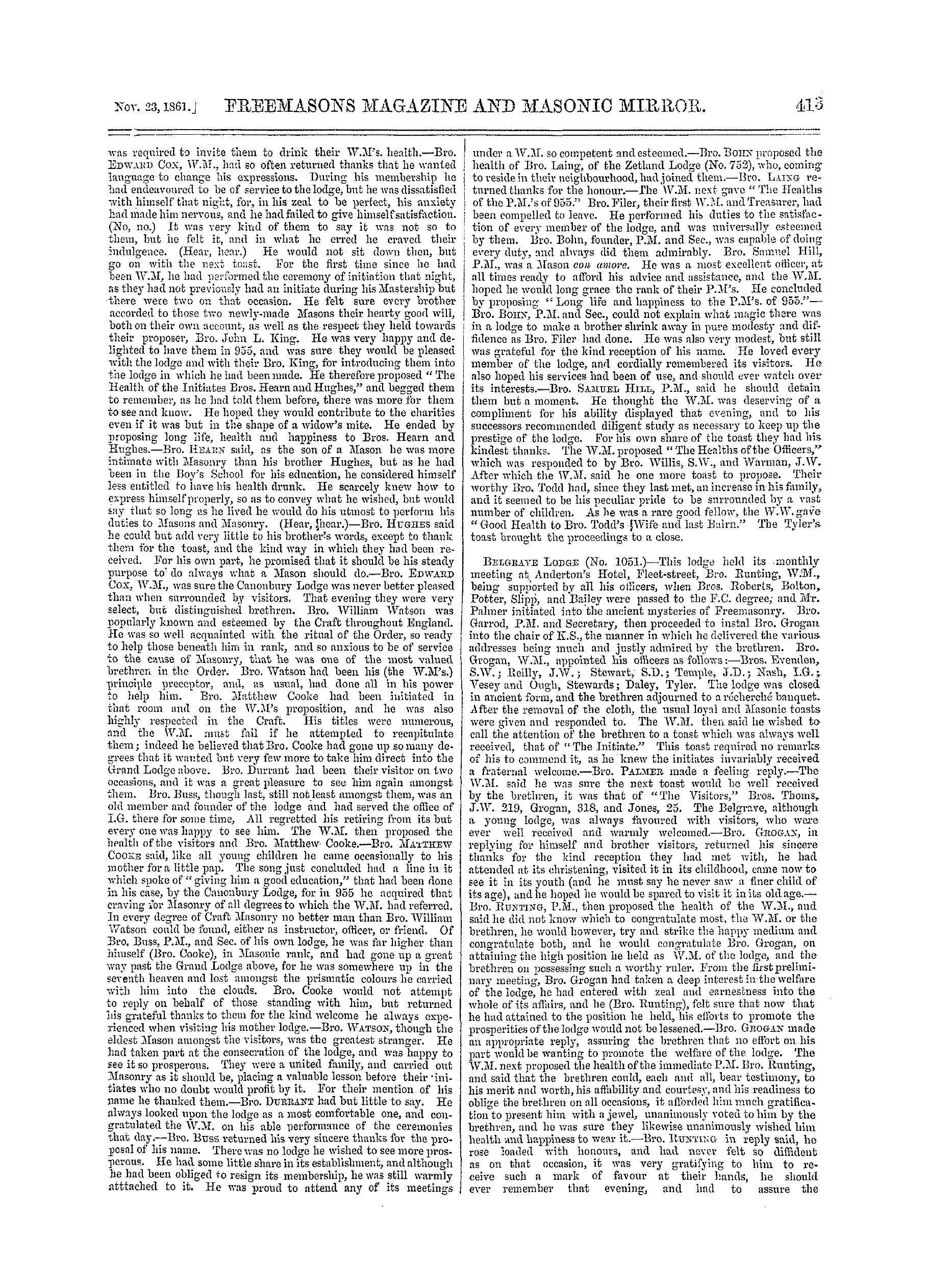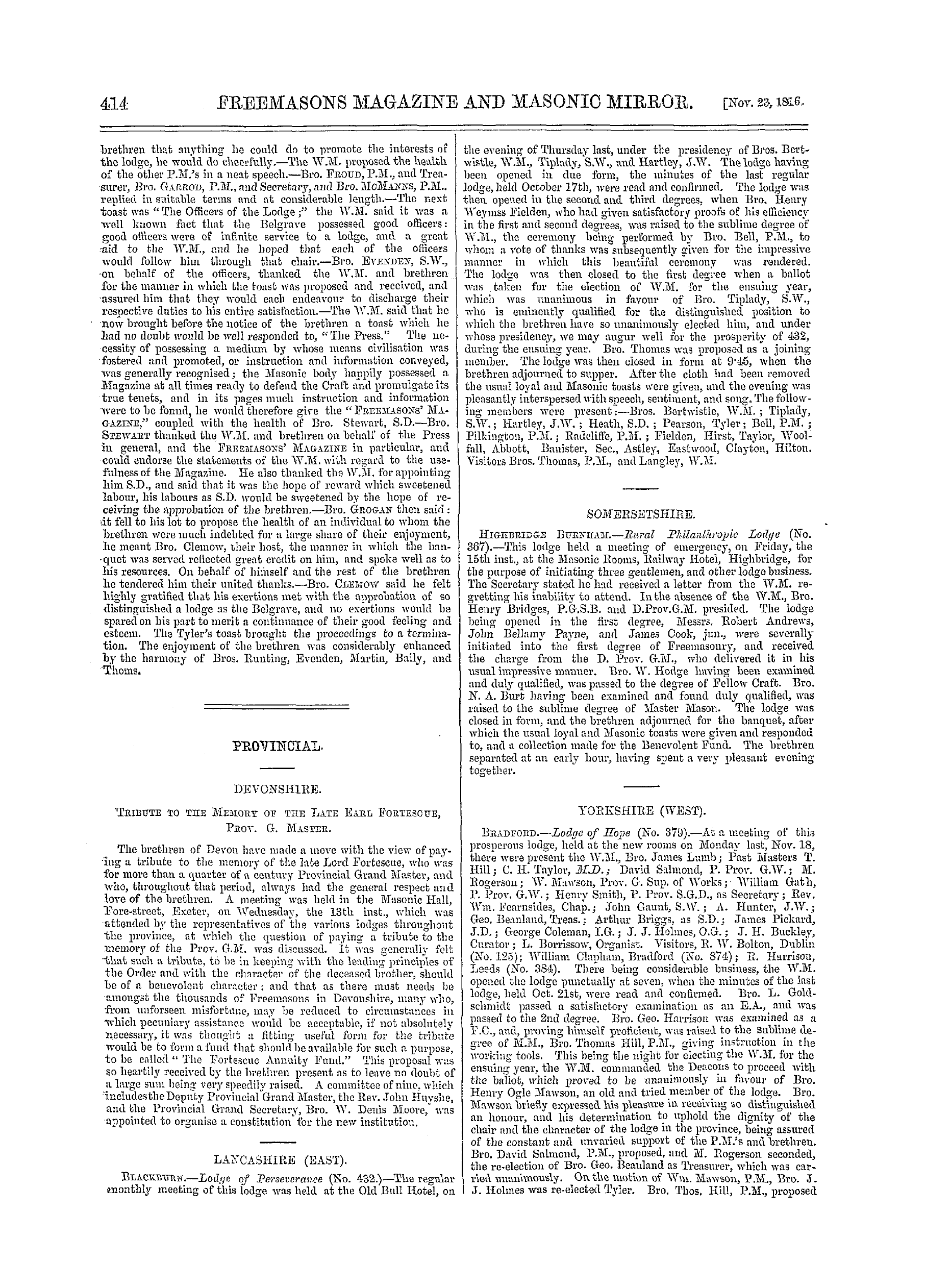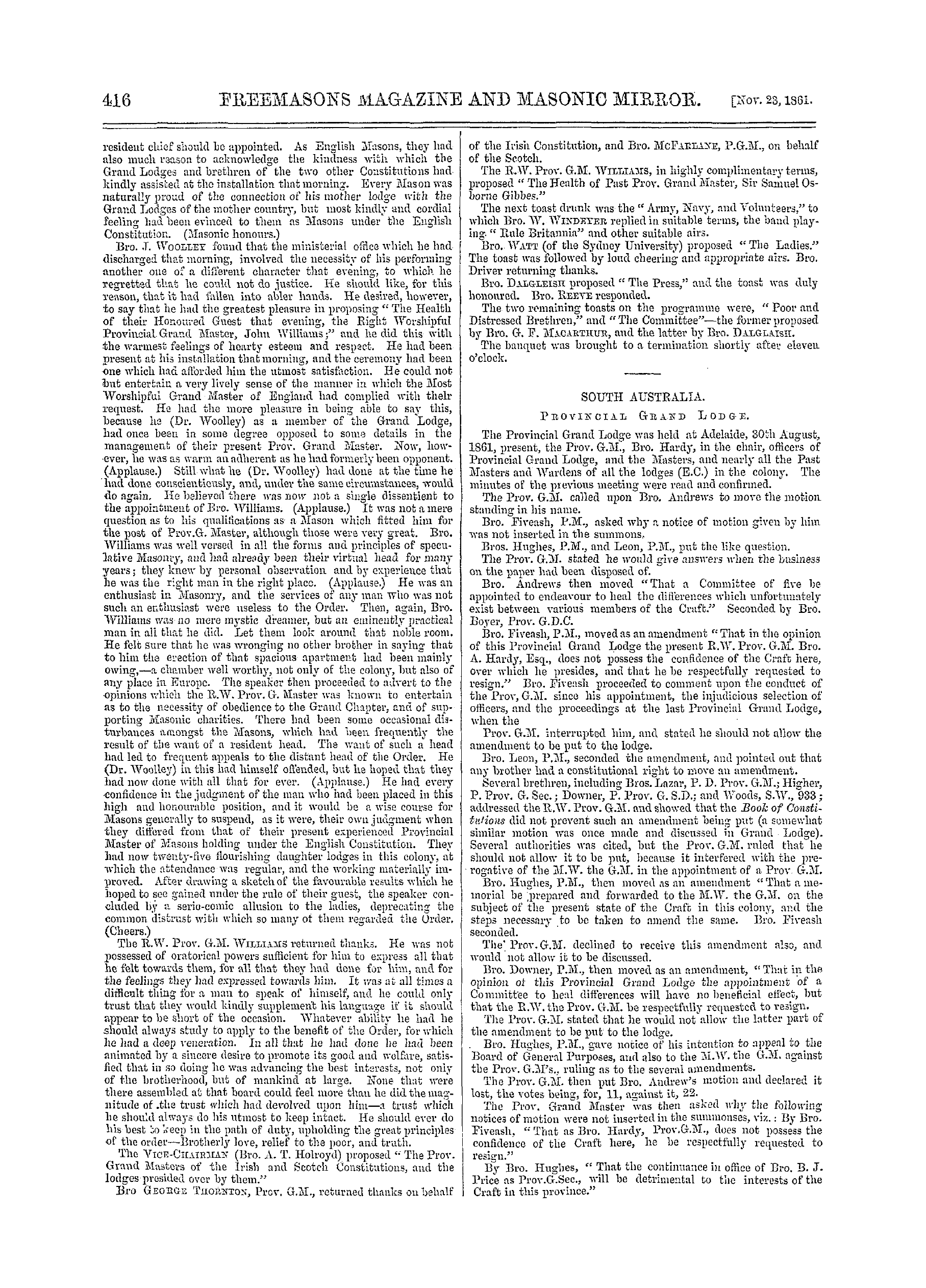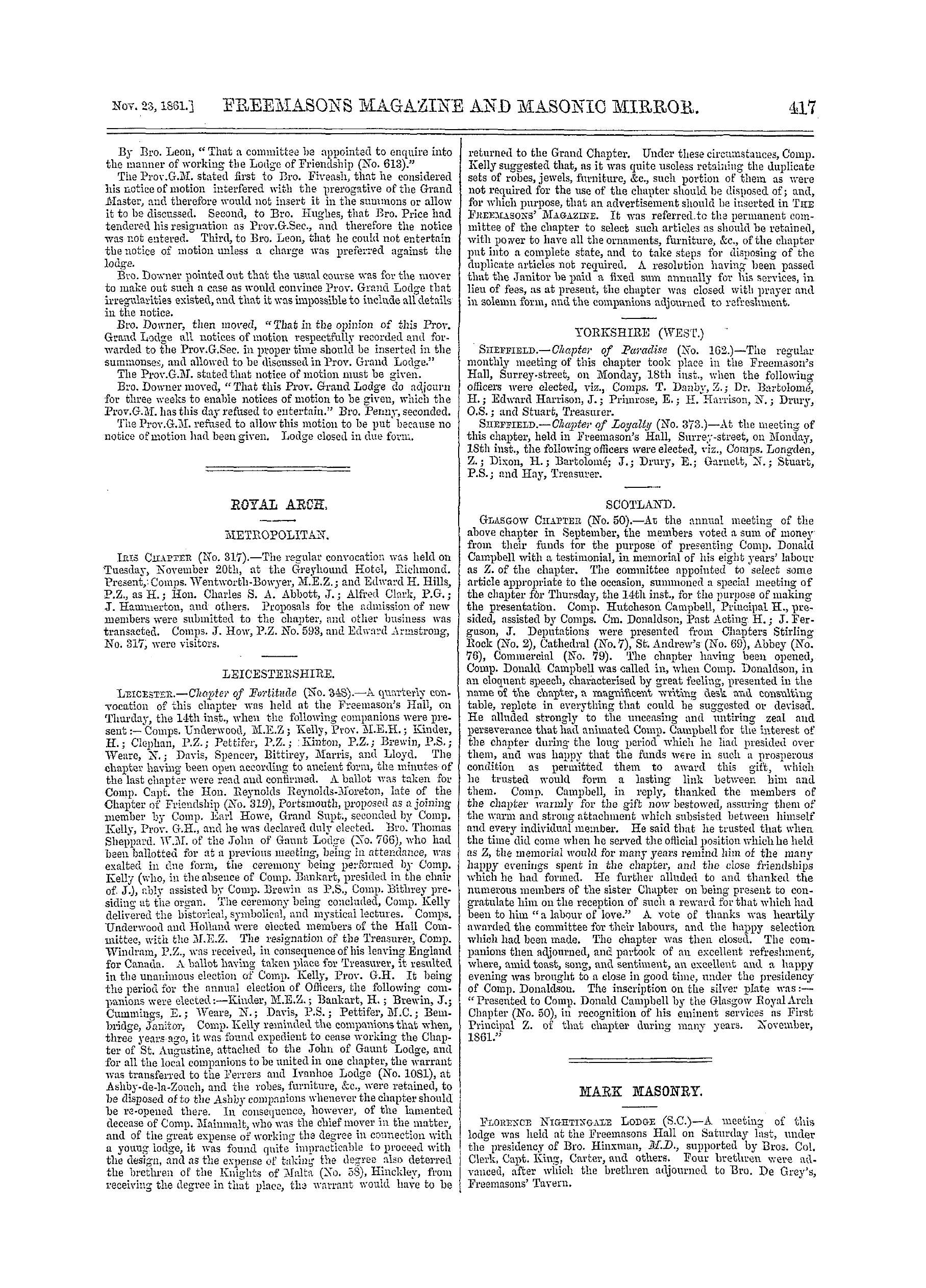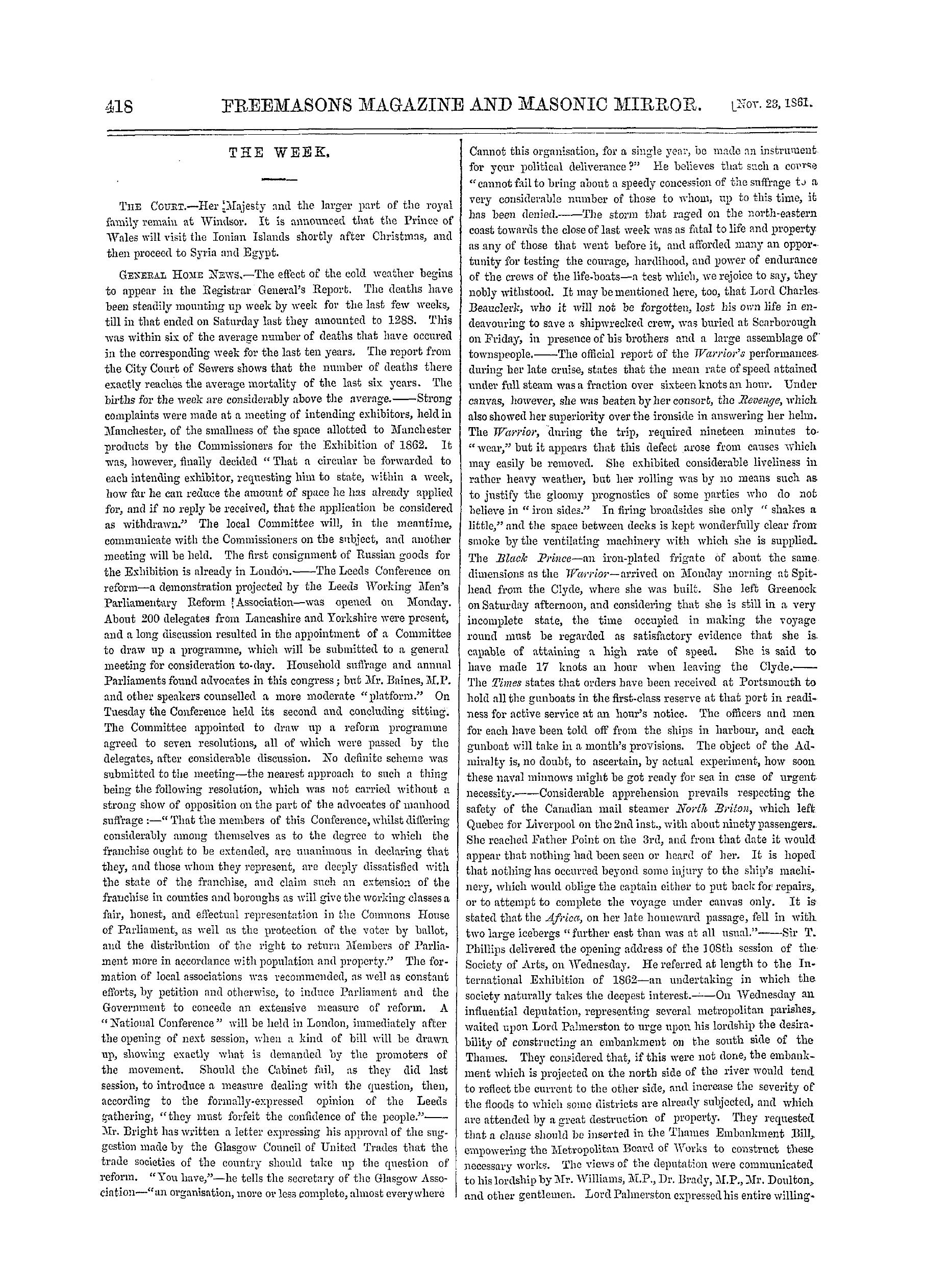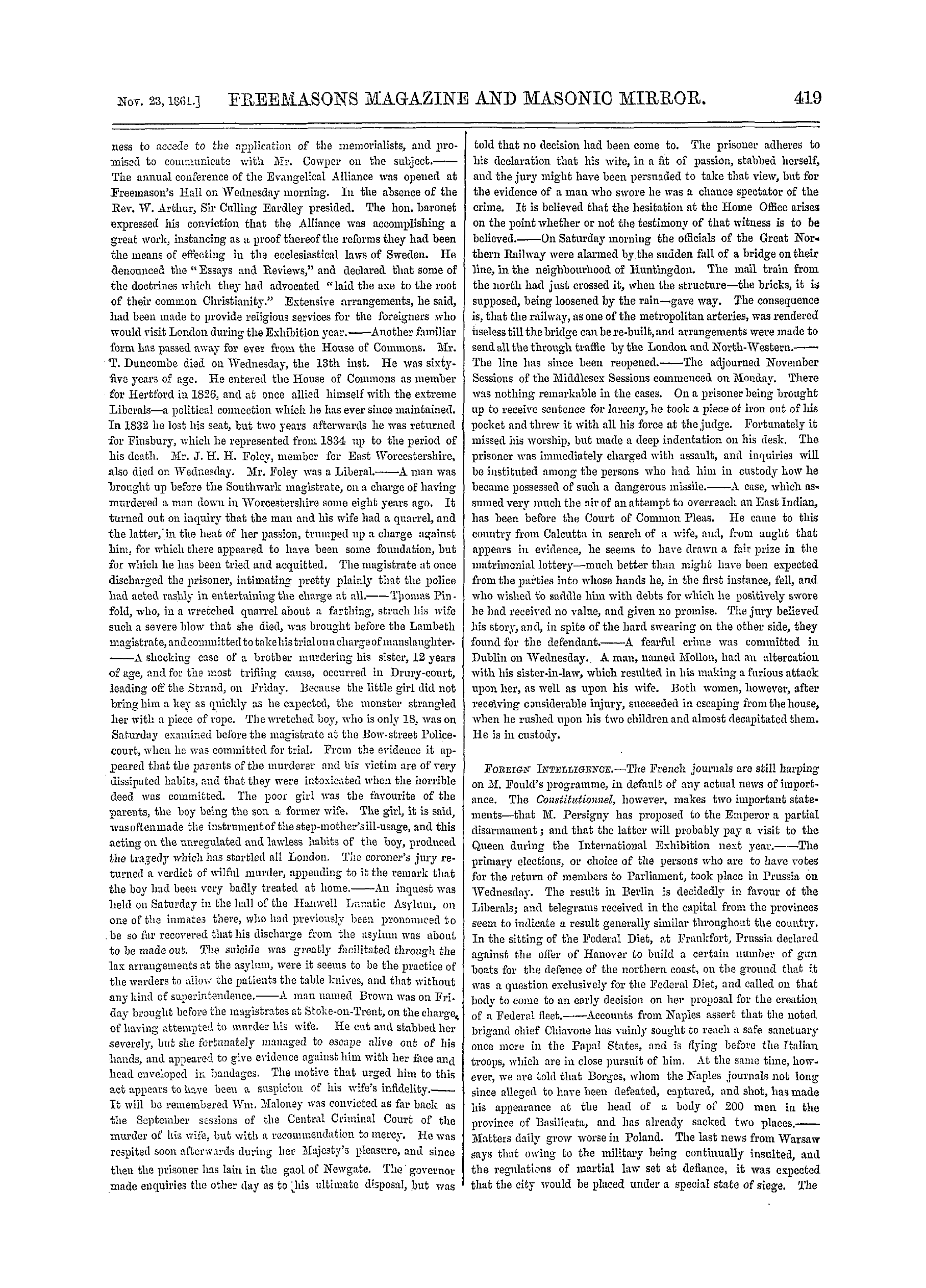-
Articles/Ads
Article CURRENT TOPICS.* ← Page 5 of 6 →
Note: This text has been automatically extracted via Optical Character Recognition (OCR) software.
Current Topics.*
Battle of Maida ; at the Siege of Copenhagen ; as Aide-de-Camp to Sir J . Moore , in 1 S 0 S-1809 . In the AValcheren Expedition , Sir William , then Captain Pasley , was wounded twice ; he then served in the Peninsular AVar until 1812 ; and in 1813 , he was appointed Director of the lloyal Engineer ' s Establishment , at Chatham , a post he retained until his nomination as major-general in 1841 . The connection of General Pasley with our profession , is to be sought principallin the various papers inserted hhim in the
y y Corps papers of the JRoyal Engineers ; in his " Observations on Limes , and Calcareous cements , " 8 vo ., London , 1838 ; in the interesting operations for the removal of the wreck of the Poyal George , and in blasting the Eown Down Cliff , near Dover ; indirectly , his duties as Inspector of Railways , also brought General Pasley hi contact witn some of the members of our profession . Perhaps I may be allowed especially to call attention to the part
which Sir William bore in the introduction of the artificial , overcalcined cements , known at the present day by the name of the Portland cements . In this instance , Sir AVilliam worked in connexion with the late Mr . Frost , and those gentleman seem only to have missed the discovery ofthe influence of excessive calcination upon the action of the slow setting cements , in their curious and valuable researches . General Sir AVilliam Pasley died on the 19 th April 1 S 61 .
, Mr . Eaton Hodgkinson was one of the students of the abstruser branches of science connected with our profession , whose labors will long continue to influence its practical details , and he may also he cited as one of those who achieved distinction by his " selfhelp , " even while following studies of the most recondite order . Without any adventitnous aids from family connexion , or of wealth , Mr . Hodgkinson had succeeded in making himself sufficiently
known for his acquaintance ivith the application of the higher branches of mathematics to the physical sciences ( especially by th publication of a paper , in the Memoirs of the Manchester Society for 1822 ) , to be employed by the engineers of that very practical town to conduct some experiments on the strength of cast-iron , and on the best form of section to be adopted for girders . Previouslto the publication of Mr . Hodkinson's inquiriesthe
y g , rules laid down by Tredgold on these subjects had been universally received by practical men ; and he reasoned upon the supposition that cast-iron , like other solid bodies , resisted equally the force of compression , exercised upon the top or upon the "bottom , when loaded as a beam . Tredgold therefore inferred that the best form
of section would be one resembling the letter I , with equal flanges at the top and at the bottom . Hodgkinson , however , discovered that cast-iron presented some anomalous conditions of elasticity , and that especially it resisted efforts of compression with an energy which was nearly six timos as great as the energy with which it resisted efforts of extension ; he was thus led to recommend a form of cross section for girders iu which the upper and lower flanges were made to present sectional areas corresponding with the efforts
of compression and of extension they would respectively have to resist . The late George Stephenson was one of the first engineers to adopt this form of girder , for the bridge on the Liverpool and Manchester railway , over Water-street , Manchester , erected in 1830 ; since then it has heen adopted universally , though for my own part I confess that the unequal rates of cooling in the top and bottom flanges of Mr . Hodgkinson ' s form of girders seems to me to involve a very serious practical danger , on the score of the
soundness of the casting in which the areas of the flanges are so markedly unequal . U Mr . Hodgkinson then devoted his time and attention to a series of investigations into the general laws of the elasticity of rigid bodies , and of the strength of pillars of cast-iron and ' of other materials . His methods of observations were far from being as elegant or refined as those adopted by M . AVertheim , but they have been made more practically usefuland the empirical formula !
, deduced from them still regulate the practice of engineers and architects . Mr . Hodgkinson ' s results were published in the Transactions of the Koyal Society in 1840 , and they ivere Judged worthy to secure their author the JRoyal Gold Medal , and his nomination as a member of that learned body . In 1845 Mr . Hodgkinson was engaged by Mr . Robert Stephenson , in conjunction ivith Mr . Fairbairn , in the experiments it was considered necessary to make previously to constructing the tubes of the
Conway and of the Britannia bridges ; and it is to the results so obtained that we are indebted for the wonderful change introduced in the building arts by the application of wrought-iron , plain , and and boxed girders . The most important facts thus elicited b y Mr . Hodgkinson were communicated hy him to the " Commissioners to inquire into the application of iron to railway structures " named in 1847 , in consequence of the failure of the Dee-bridge at Chester , and
were published by them in their report . In the fourth report of the British Association is inserted a paper by Mr . Hodgkinson on the "Collision of Imperfectl y Elastic Bodies ' , " and on "Impact upon Beams ; " in 1842-46 be also published a second edition of
" Tredgold on the Strength of Cast-iron ; and from time to time he inserted various other scientific papers in the Transactions of the British Association , of the Eoyal Society , and of the Literary and Philosophical Society of Manchester . It would be very desirable to collect and arrange , in systematic order , these various detached essavs .
Mr . Hodgkinson was born on 29 th Februarv , 1789 , and died on 18 th June , 1861 . Sir AA'illiam Cubitt was , perhaps , more immediately connected with our profession than the other eminent men hitherto noticed , on acecounfc of his connexion with the original Crystal Palace . Sir AA illiam was the son of a miller , of Dilham , in Norfolk , and at an early age he was apprenticed to a joiner ; after some years , spent in the exercise of his trade and in the works required for
repairing the mills of the district in which he was educated , he entered the factory of Messrs . Eansome , the agricultural implement makers and mechanical engineers , of Ipswich . In their employment , Sir AA'illiam became practically acquainted with the details of civil engineering , and about this period of his life he invented the selfwinding apparatus of windmills , and that important instrument cf prison discipline , the treadmill . About 1826 , he removed to Londonand began business on his oivn account as a civil engineer ,
, and , by dint of perseverance , industry , and honourable conduct , he slowly attained the foremost rank of his profession . The works executed by Sir AVilliam Cubitt on the Norfolk and Lowestoft Navigation , on the Severn Navigation , the South Eastern , and the Great Northern Hallways , the landing stage ' s at Liverpool , the nev . - Eochester Town Bridge , the Berlin Waterworks , < Scc , may be referred to as illustrations of his practical genius and ability , and it is not too much to say that the manner in which the South
Eastern line is carried between Folkestone ancl Dover , is one of the boldest pieces of engineering of which we have examples in England . In 1851 , Sir AVilliam was charged with the superintendence of the working details of the Crystal Palace , and for his exertions on that occasion he received the honour of Knighthood . Sir AA illiam Cubitt was born in 1785 ; he died , October 13 th , 1861 . Mr . Robert Grainger , like Sir AA'illiam Cubitt , furnished another illustration of the ease with which real talent and sound character
may achieve distinction in our country . Grainger began iu the very lowest ranks of life , and even received his education in a charity school . By dint of energy , prudence , and economy , he soon raised himself above immediate want , and , having been fortunate enough to marry a lady of some fortune , he was enabled to enter upon the bold scheme of speculative building , which so changed the aspect of his native town , and , after some viscissitudes , lefb
him a wealthy man m his later days . It would be invidious to criticise the style of building adopted by Mr . Grainger , and , after all , a man should be judged , in his artistic capacity at least , by the standard of his times rather than by a comparison with the productions of more recent periods . Mr . Grainger's neiv streets and open spaces in and about Grey-town , in Newcastle , ivhen judged upon these principles , must appear to be considerably in advance of the provincial street architecture of his times , ancl the manner in
which ho introduced stone instead of brick in the elevations has certainly given a monumental character to designs which , in themselves , would not have attracted much attention . The new market , exchange , theatre , dispensary , music hall , etc ., of Newcastle , are works of considerable merit , and though , no doubt , Air . John Dobson contributed much of their artistic character , it is to Mr . Grainger that the inhabitants of Newcastle are indebted for these important buildings . Mr . Grainger died 4 th JulyIS 61 iu the
, , 63 vd year of his age . Professor Hosking , horn in 1808 , died 2 nd August , 1861 , was in his very early life apprenticed to a carpenter and builder , in Neiv South Wales , but in 1820 he was articled to Mr . Jenkins , architect , of Bed Lion-square . I believe that he took lessons in drawing of Mr . George Maddox , and after leaving Air . Jenkins he travelled in Italy and Sicily . Some lectures on architecture , delivered at the AVestern Literary and Scientific Institutionled to his
being-, engaged to write the articles "Architecture and B-.-iidhig , " in the Fnegelopcedia Srittaniea , which at once established his reputation as an Architectural critic . Mr . Hosking very wisely refused to recognise the modern distinction between the professions of architecture and civil engineer , and in 1834 he executed the works of what is now knoivn as the AVest London Kail-way . Upon this line he constructed , amongst other works , a very remarkable hridge
near Kensal-green , by which the canal and the common turnpike road are carried over the railway , and it may be added that in most of the foreign works on construction , this architectural piece of civil engineering has been reproduced . Mr . Hosking also designed and executed the Abney-park Cemetry , and some rather important private buildings about London , but he was most known from the fact of his having been named one of the official referees under th-3 Building Act of IS 44 , and from his having filled the professorship of the principles and practice of architecture , at Kins's CoHese ,
Note: This text has been automatically extracted via Optical Character Recognition (OCR) software.
Current Topics.*
Battle of Maida ; at the Siege of Copenhagen ; as Aide-de-Camp to Sir J . Moore , in 1 S 0 S-1809 . In the AValcheren Expedition , Sir William , then Captain Pasley , was wounded twice ; he then served in the Peninsular AVar until 1812 ; and in 1813 , he was appointed Director of the lloyal Engineer ' s Establishment , at Chatham , a post he retained until his nomination as major-general in 1841 . The connection of General Pasley with our profession , is to be sought principallin the various papers inserted hhim in the
y y Corps papers of the JRoyal Engineers ; in his " Observations on Limes , and Calcareous cements , " 8 vo ., London , 1838 ; in the interesting operations for the removal of the wreck of the Poyal George , and in blasting the Eown Down Cliff , near Dover ; indirectly , his duties as Inspector of Railways , also brought General Pasley hi contact witn some of the members of our profession . Perhaps I may be allowed especially to call attention to the part
which Sir William bore in the introduction of the artificial , overcalcined cements , known at the present day by the name of the Portland cements . In this instance , Sir AVilliam worked in connexion with the late Mr . Frost , and those gentleman seem only to have missed the discovery ofthe influence of excessive calcination upon the action of the slow setting cements , in their curious and valuable researches . General Sir AVilliam Pasley died on the 19 th April 1 S 61 .
, Mr . Eaton Hodgkinson was one of the students of the abstruser branches of science connected with our profession , whose labors will long continue to influence its practical details , and he may also he cited as one of those who achieved distinction by his " selfhelp , " even while following studies of the most recondite order . Without any adventitnous aids from family connexion , or of wealth , Mr . Hodgkinson had succeeded in making himself sufficiently
known for his acquaintance ivith the application of the higher branches of mathematics to the physical sciences ( especially by th publication of a paper , in the Memoirs of the Manchester Society for 1822 ) , to be employed by the engineers of that very practical town to conduct some experiments on the strength of cast-iron , and on the best form of section to be adopted for girders . Previouslto the publication of Mr . Hodkinson's inquiriesthe
y g , rules laid down by Tredgold on these subjects had been universally received by practical men ; and he reasoned upon the supposition that cast-iron , like other solid bodies , resisted equally the force of compression , exercised upon the top or upon the "bottom , when loaded as a beam . Tredgold therefore inferred that the best form
of section would be one resembling the letter I , with equal flanges at the top and at the bottom . Hodgkinson , however , discovered that cast-iron presented some anomalous conditions of elasticity , and that especially it resisted efforts of compression with an energy which was nearly six timos as great as the energy with which it resisted efforts of extension ; he was thus led to recommend a form of cross section for girders iu which the upper and lower flanges were made to present sectional areas corresponding with the efforts
of compression and of extension they would respectively have to resist . The late George Stephenson was one of the first engineers to adopt this form of girder , for the bridge on the Liverpool and Manchester railway , over Water-street , Manchester , erected in 1830 ; since then it has heen adopted universally , though for my own part I confess that the unequal rates of cooling in the top and bottom flanges of Mr . Hodgkinson ' s form of girders seems to me to involve a very serious practical danger , on the score of the
soundness of the casting in which the areas of the flanges are so markedly unequal . U Mr . Hodgkinson then devoted his time and attention to a series of investigations into the general laws of the elasticity of rigid bodies , and of the strength of pillars of cast-iron and ' of other materials . His methods of observations were far from being as elegant or refined as those adopted by M . AVertheim , but they have been made more practically usefuland the empirical formula !
, deduced from them still regulate the practice of engineers and architects . Mr . Hodgkinson ' s results were published in the Transactions of the Koyal Society in 1840 , and they ivere Judged worthy to secure their author the JRoyal Gold Medal , and his nomination as a member of that learned body . In 1845 Mr . Hodgkinson was engaged by Mr . Robert Stephenson , in conjunction ivith Mr . Fairbairn , in the experiments it was considered necessary to make previously to constructing the tubes of the
Conway and of the Britannia bridges ; and it is to the results so obtained that we are indebted for the wonderful change introduced in the building arts by the application of wrought-iron , plain , and and boxed girders . The most important facts thus elicited b y Mr . Hodgkinson were communicated hy him to the " Commissioners to inquire into the application of iron to railway structures " named in 1847 , in consequence of the failure of the Dee-bridge at Chester , and
were published by them in their report . In the fourth report of the British Association is inserted a paper by Mr . Hodgkinson on the "Collision of Imperfectl y Elastic Bodies ' , " and on "Impact upon Beams ; " in 1842-46 be also published a second edition of
" Tredgold on the Strength of Cast-iron ; and from time to time he inserted various other scientific papers in the Transactions of the British Association , of the Eoyal Society , and of the Literary and Philosophical Society of Manchester . It would be very desirable to collect and arrange , in systematic order , these various detached essavs .
Mr . Hodgkinson was born on 29 th Februarv , 1789 , and died on 18 th June , 1861 . Sir AA'illiam Cubitt was , perhaps , more immediately connected with our profession than the other eminent men hitherto noticed , on acecounfc of his connexion with the original Crystal Palace . Sir AA illiam was the son of a miller , of Dilham , in Norfolk , and at an early age he was apprenticed to a joiner ; after some years , spent in the exercise of his trade and in the works required for
repairing the mills of the district in which he was educated , he entered the factory of Messrs . Eansome , the agricultural implement makers and mechanical engineers , of Ipswich . In their employment , Sir AA'illiam became practically acquainted with the details of civil engineering , and about this period of his life he invented the selfwinding apparatus of windmills , and that important instrument cf prison discipline , the treadmill . About 1826 , he removed to Londonand began business on his oivn account as a civil engineer ,
, and , by dint of perseverance , industry , and honourable conduct , he slowly attained the foremost rank of his profession . The works executed by Sir AVilliam Cubitt on the Norfolk and Lowestoft Navigation , on the Severn Navigation , the South Eastern , and the Great Northern Hallways , the landing stage ' s at Liverpool , the nev . - Eochester Town Bridge , the Berlin Waterworks , < Scc , may be referred to as illustrations of his practical genius and ability , and it is not too much to say that the manner in which the South
Eastern line is carried between Folkestone ancl Dover , is one of the boldest pieces of engineering of which we have examples in England . In 1851 , Sir AVilliam was charged with the superintendence of the working details of the Crystal Palace , and for his exertions on that occasion he received the honour of Knighthood . Sir AA illiam Cubitt was born in 1785 ; he died , October 13 th , 1861 . Mr . Robert Grainger , like Sir AA'illiam Cubitt , furnished another illustration of the ease with which real talent and sound character
may achieve distinction in our country . Grainger began iu the very lowest ranks of life , and even received his education in a charity school . By dint of energy , prudence , and economy , he soon raised himself above immediate want , and , having been fortunate enough to marry a lady of some fortune , he was enabled to enter upon the bold scheme of speculative building , which so changed the aspect of his native town , and , after some viscissitudes , lefb
him a wealthy man m his later days . It would be invidious to criticise the style of building adopted by Mr . Grainger , and , after all , a man should be judged , in his artistic capacity at least , by the standard of his times rather than by a comparison with the productions of more recent periods . Mr . Grainger's neiv streets and open spaces in and about Grey-town , in Newcastle , ivhen judged upon these principles , must appear to be considerably in advance of the provincial street architecture of his times , ancl the manner in
which ho introduced stone instead of brick in the elevations has certainly given a monumental character to designs which , in themselves , would not have attracted much attention . The new market , exchange , theatre , dispensary , music hall , etc ., of Newcastle , are works of considerable merit , and though , no doubt , Air . John Dobson contributed much of their artistic character , it is to Mr . Grainger that the inhabitants of Newcastle are indebted for these important buildings . Mr . Grainger died 4 th JulyIS 61 iu the
, , 63 vd year of his age . Professor Hosking , horn in 1808 , died 2 nd August , 1861 , was in his very early life apprenticed to a carpenter and builder , in Neiv South Wales , but in 1820 he was articled to Mr . Jenkins , architect , of Bed Lion-square . I believe that he took lessons in drawing of Mr . George Maddox , and after leaving Air . Jenkins he travelled in Italy and Sicily . Some lectures on architecture , delivered at the AVestern Literary and Scientific Institutionled to his
being-, engaged to write the articles "Architecture and B-.-iidhig , " in the Fnegelopcedia Srittaniea , which at once established his reputation as an Architectural critic . Mr . Hosking very wisely refused to recognise the modern distinction between the professions of architecture and civil engineer , and in 1834 he executed the works of what is now knoivn as the AVest London Kail-way . Upon this line he constructed , amongst other works , a very remarkable hridge
near Kensal-green , by which the canal and the common turnpike road are carried over the railway , and it may be added that in most of the foreign works on construction , this architectural piece of civil engineering has been reproduced . Mr . Hosking also designed and executed the Abney-park Cemetry , and some rather important private buildings about London , but he was most known from the fact of his having been named one of the official referees under th-3 Building Act of IS 44 , and from his having filled the professorship of the principles and practice of architecture , at Kins's CoHese ,
